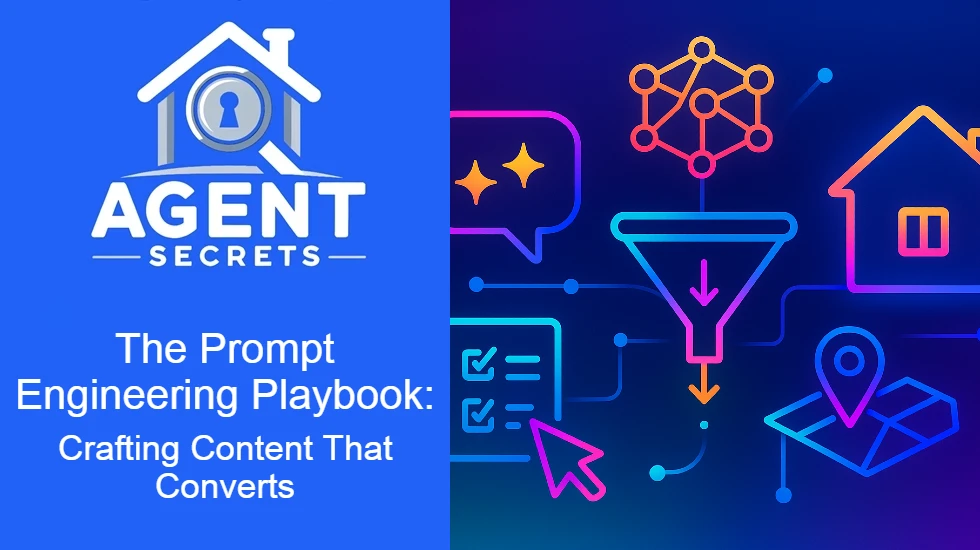Crafting Content That Converts
Series: Unlock the AI Advantage in Real Estate Marketing (4-part series)
Host: Kristie Filion, SuccessWebsite
🎥 Watch the Replay
Learn how to turn features into emotion-driven copy for listings, emails, ads, and blog posts—using clear, reusable prompt frameworks.
What you’ll learn in this session
- Generic vs. emotion-driven listing copy: why the prompt determines the output.
- Buyer psychology basics: home decisions start emotional, then get justified with logic.
- Prompt structure that works: clarity, tone, format, and examples (what to tell the model).
- Reusable brand frameworks: fashion/lifestyle, transformation (à la Nike), and minimalist “Apple” angles.
- Live prompt demonstrations: tailoring copy for first-time buyers and empty nesters.
- Consistency = trust: how a 6-month cadence of blogs + email boosts top-of-mind authority.
Fast recap (5 big ideas)
- Specific in = specific out. Give the model address, archetype (e.g., first-time buyer), desired feeling, constraints (length, bullets, no hype).
- Write for who they’ll become. Tie features to identity, routines, and effortless living.
- Set the voice. Tell the model: conversational vs. formal, bullets vs. paragraphs, emoji or none, “no clichés,” etc.
- Use frameworks on purpose.
- Fashion/Lifestyle: confidence, social moments, personal style.
- Transformation (Nike): who the buyer becomes here; frictions removed.
- Apple Simplicity: essential words, one strong adjective per feature, subtle exclusivity.
- Systematize. Save your best prompts as swipe files; reuse for blogs, listing descriptions, ads, and email.
Swipe-worthy prompt templates (adapted from the session)
Replace [ADDRESS], [BUYER TYPE], and bracketed items with your details.
Emotion-Driven Listing Prompt
“Write a listing description for [ADDRESS]. Goal: make readers feel a peaceful, low-maintenance lifestyle. Include sensory details, subtle status, and a soft urgency close (priced to move). Use a conversational tone, 140–180 words, no clichés, no superlatives.”
First-Time Buyer Angle
“Create a 120–160-word property blurb that helps a first-time buyer envision independence and pride of ownership. Focus on ‘finally having’ moments (keys in hand, first dinner). Keep sentences short. End with a gentle invitation to view.”
Empty-Nester Angle
“Describe this home as the reward for years of work: simplified living, lock-and-leave ease, and room for visiting family. 150–200 words, warm tone, light bullets for key conveniences (storage, natural light, low-maintenance finishes).”
Blog + Email Combo Prompt
“Write a 500-word blog post for [CITY/NEIGHBORHOOD] homeowners about how emotion-based prompts improve listing results. Include a short CTA to join my newsletter. Then write a 120-word email that teases the blog with 3 bullets and a link.”
The 7 Fatal Flaws That Quietly Kill Referrals
- Generic positioning – Generalists blend in; specialists get remembered.
- Assuming happy clients = referrals – Satisfaction alone doesn’t activate word-of-mouth.
- Being the “invisible” expert – Showcase your insights publicly to build credibility.
- Transaction-only thinking – Stay connected long after closing day.
- Fear of asking – Integrate the referral ask naturally into your follow-up systems.
- Social-proof shortage – Collect and highlight reviews, especially local ones.
- Generic communication – Publish content your competitors can’t, rooted in hyper-local expertise.
Our team of digital marketing experts has 27+ years of experience designing effective follow-up strategies, plus technology you can leverage to get more conversations with less effort. To learn more, click the green button below to get started with a free marketing assessment.

